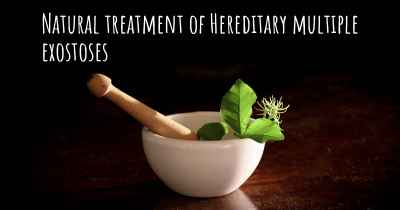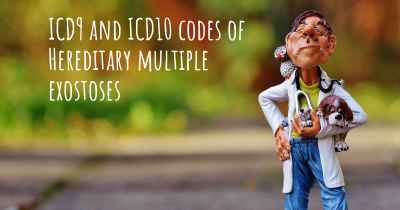What are the best treatments for Hereditary multiple exostoses?
See the best treatments for Hereditary multiple exostoses here

Hereditary multiple exostoses (HME), also known as multiple osteochondromas, is a rare genetic disorder characterized by the development of multiple benign bone tumors called osteochondromas. These tumors typically appear during childhood or adolescence and can affect various bones in the body, including the long bones, ribs, and pelvis. While the tumors are generally non-cancerous, they can cause significant pain, deformities, and functional limitations.
Treatment for hereditary multiple exostoses aims to manage symptoms, prevent complications, and improve quality of life. The approach may vary depending on the severity of the condition, the number and location of tumors, and the individual's specific needs. Here are some of the most commonly used treatments:
1. Regular monitoring and surveillance
Individuals with hereditary multiple exostoses require regular monitoring to assess the growth and potential complications of the osteochondromas. This typically involves periodic clinical examinations, X-rays, and other imaging studies. Early detection of any changes or complications allows for timely intervention.
2. Surgical intervention
Surgery is often necessary to address symptomatic or problematic osteochondromas. The goals of surgery may include relieving pain, improving joint function, correcting deformities, and preventing nerve or blood vessel compression. The specific surgical procedures depend on the location and size of the tumors, as well as the individual's symptoms and functional limitations.
Excision is the most common surgical technique used to remove osteochondromas. It involves cutting out the tumor along with a small portion of the adjacent normal bone. In some cases, the surgeon may need to perform more complex procedures, such as osteotomy (cutting and realigning bones) or arthroplasty (joint reconstruction).
3. Physical therapy and rehabilitation
Physical therapy plays a crucial role in managing hereditary multiple exostoses. It focuses on improving joint mobility, muscle strength, and overall function. Physical therapists can design personalized exercise programs to address specific limitations and help individuals adapt to any deformities caused by the osteochondromas. They may also provide pain management techniques and assistive devices, such as braces or crutches, to enhance mobility and reduce discomfort.
4. Pain management
Chronic pain is a common symptom associated with hereditary multiple exostoses. Pain management strategies may include over-the-counter or prescription pain medications, nonsteroidal anti-inflammatory drugs (NSAIDs), and physical modalities like heat or cold therapy. In some cases, local injections of corticosteroids or anesthetics may be used to alleviate pain and inflammation around the osteochondromas.
5. Orthopedic devices and assistive aids
Orthopedic devices such as braces, splints, or shoe inserts can be beneficial in managing symptoms and improving function. They can help support weakened joints, correct deformities, and reduce pain associated with hereditary multiple exostoses. Assistive aids like crutches or canes may also be recommended to enhance mobility and reduce stress on affected bones.
6. Genetic counseling
Given that hereditary multiple exostoses is a genetic condition, genetic counseling can be valuable for affected individuals and their families. Genetic counselors can provide information about the inheritance pattern, assess the risk of passing the condition to future generations, and discuss available options for family planning.
In conclusion, hereditary multiple exostoses is a complex condition that requires a multidisciplinary approach to treatment. Regular monitoring, surgical intervention when necessary, physical therapy, pain management, orthopedic devices, and genetic counseling are all important components of managing this condition. Early diagnosis and intervention can significantly improve outcomes and enhance the quality of life for individuals with hereditary multiple exostoses.
Posted Sep 12, 2017 by Helmina Batubara 700
Surgery may be required to relieve pain, improve movement, restore normal circulation, or for cosmetic reasons.
Monitoring the size of affected bones by annual scans to screen for malignant degeneration is sometimes recommended. In that condition surgery is needed.
Rapid growth and increased pain are signs of a possible malignant change.
Genetic counseling is recommended for affected individuals and their families.
Posted Nov 30, 2017 by Zahra 1950
Posted Dec 1, 2017 by Diana 920








